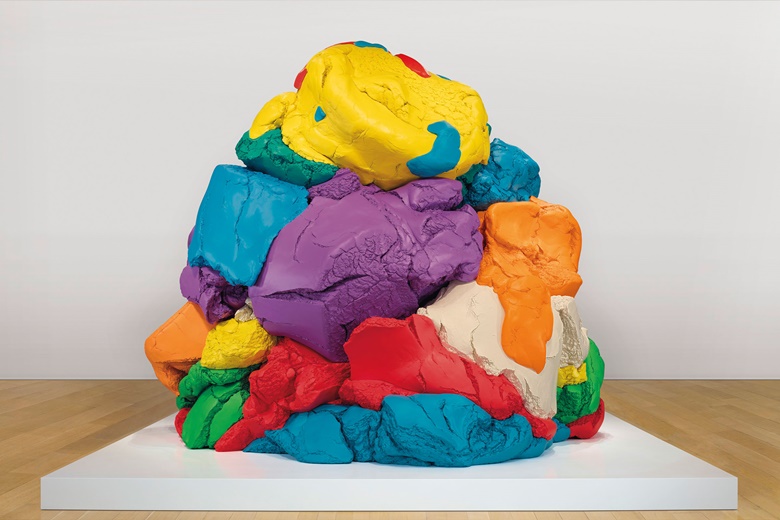How Do You Say Playdoh Arts Market in English
Created over the grade of two decades, this massive piece of work became an instant icon when information technology debuted at the Whitney Museum in 2014. Here, the artist tells us virtually his meticulous, epic recreation of a child's toy — offered in New York on 17 May
In 2014, Jeff Koons (b. 1955) was the subject of a retrospective at the Whitney Museum of American Art in New York. Information technology was in this colossal prove that the artist debuted his monumental sculpture, Play-Doh , a sculpture that had already become legendary in the two decades of its creation.
Play-Doh is one of the largest and most complex works in Koons'Celebration series, a group begun in the mid-1990s, which includes such contemporary icons as Balloon Dog, Hanging Heart and Tulips. In these pieces Koons pushed fabrication techniques to new heights; today, the series has go nearly mythic.
The result of the creative person's single-minded dedication to producing the perfect finish is all too visible in Play-Doh, with its crevices, curves, and the faint sheen of its matte colours. Viewers would exist forgiven for thinking that they are really looking at a Brobdingnagian mass of Play-Doh, with vibrant colours piled on top of each other. So convincing is the surface that, for many, information technology triggers babyhood memories of play and creativity — that age before the constraints of taste and learning have been imposed.

'I've e'er wanted anybody coming into contact with my work to feel excitement through the senses,' Koons explains, andPlay-Doh does exactly that. 'You have the different colours. You accept the bear upon, the feeling of it. Only yous also have the smell, the odor of the material. I wanted to create something archetypal, that would connect you to what information technology really means to exist human.'
But if the sculpture is intended to appeal to the viewer on an instinctual, sensory level, the process by which it was synthetic was painstaking and decidedly cerebral.Play-Doh was assembled through the utilize of 27 perfectly interlocking sections of painted aluminium. Gravity alone fastens them together, the weight of each colour pressing down on the next. Koons' exacting criteria runs to intriguing extremes: each of these pieces is painted in its entirety, not just the facet visible whenPlay-Doh is fully assembled. In each of the 5 versions the artist created, the colour configuration is unique.
'Never has a sculpture and then obviously unproblematic been so deeply complex to create,' says Francis Outred, Head of Post-State of war and Gimmicky Art at Christie's in London. 'This was the sculpture that took the longest to produce and pushed its creator to new feats of engineering.'
Information technology is a mark of the importance thatPlay-Doh has achieved within Koons' oeuvre that it has been published and exhibited extensively since information technology was outset unveiled four years agone. Reviewing its debut at the Whitney show forFrieze, Chris Wiley would refer to it as '1 of his best works to date', while Roberta Smith described it inThe New York Times as 'a new, virtually certain masterpiece'.
'What I try to practise every day as an artist is to make objects that you can't brand any judgements about' — Jeff Koons
Play-Doh was directly inspired past Koons' son Ludwig, who, as a toddler, proudly presented his father with a similar colourful creation. 'He made a mound of Play-Doh, and he said "Dad!" And I turned, "What?", and he went "Voilà!" in front end of this mound of Play-Doh. He was so proud. I looked at it, and I thought this is actually what I effort to do every day as an creative person, to brand objects that you tin can't make whatsoever judgements about. That it's perfect, that you only feel acceptance,' the artist recalls.
Past the fourth dimension Play-Doh was unveiled, Koons had already adult a reputation for seeking out highly skilled people in society to attain the furnishings he desired in his art. He corresponded with Nobel Prize-winner Richard P. Feynman when creating his Equilibrium tanks — a serial of sculptures in which basketballs bladder in a glass tank — and traditional woodcarvers and porcelain artisans in the product of his Banality and Made in Heaven series.
Architectural in its scope and intricacy, Play-Doh belies the decades of research and adroitness that went into its creation
Just his quest for perfection reached new heights with theCommemoration series. Koons was funnelling time, energy and funds into the cosmos of a series of gimmicky masterpieces, pushing for flawless finishes. Even Play-Doh's palette was the effect of an nigh quixotic dedication, as the Play-doh colours of 1994 were painstakingly recreated.
Most architectural in its scope and intricacy, the surface ofPlay-Doh belies the decades of research and adroitness that went into its creation, and the essential contributions of fabricators and scientists, metallurgists and modellers. This hyperrealism is virtually at odds with the sculpture's seemingly gestural quality: the Play-Doh has been recreated in such a mode that it appears to show traces of human bear upon in its assemblage, albeit on a gargantuan scale. In this way, Koons has managed to create an intriguing tension.
InPlay-Doh, the momentary has been immortalised and made monumental, well-nigh monolithic. Ultimately, yet, the sculpture is driven past a sense of sheer fun: the infectious enthusiasm of an artist willing to strive for two decades to recreate the appearance of Play-Doh on a vast, fifty-fifty surreal scale — and the unsaid invitation for us not to judge, but to join in.
On 17 May,Play-Doh volition be a highlight of theMail service-War and Gimmicky Art Evening Sale at Christie's in New York.
Source: https://www.christies.com/features/Play-Doh-by-Jeff-Koons-9143-3.aspx
0 Response to "How Do You Say Playdoh Arts Market in English"
Post a Comment